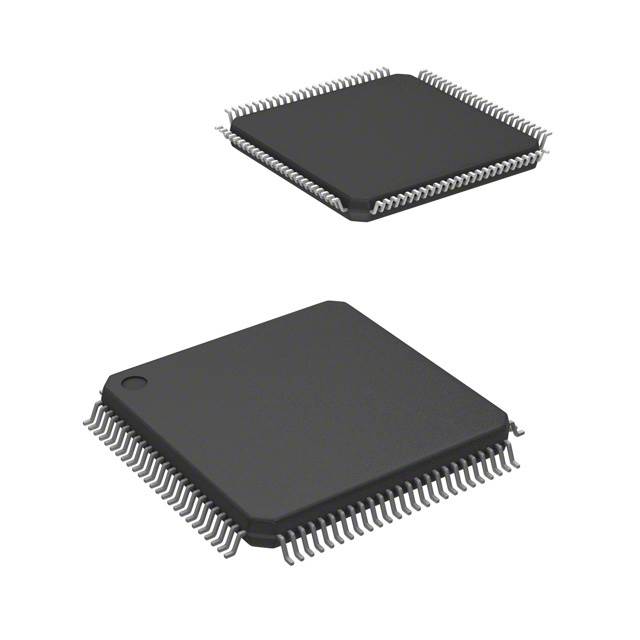ATSAM3A4CA-AU
Product Overview
Category
The ATSAM3A4CA-AU belongs to the category of microcontrollers.
Use
This microcontroller is commonly used in various electronic devices and systems for controlling and processing data.
Characteristics
- High-performance 32-bit ARM Cortex-M3 core
- Clock speed up to 84 MHz
- Flash memory capacity of 256 KB
- SRAM capacity of 48 KB
- Low power consumption
- Wide operating voltage range (1.62V to 3.6V)
- Multiple communication interfaces (UART, SPI, I2C)
- Rich set of peripherals (ADC, PWM, timers)
Package
The ATSAM3A4CA-AU is available in a surface-mount package.
Essence
This microcontroller combines high performance, low power consumption, and a rich feature set, making it suitable for a wide range of applications.
Packaging/Quantity
The ATSAM3A4CA-AU is typically packaged in reels or trays, with quantities varying based on customer requirements.
Specifications
- Microcontroller: ATSAM3A4CA-AU
- Architecture: ARM Cortex-M3
- Clock Speed: Up to 84 MHz
- Flash Memory: 256 KB
- SRAM: 48 KB
- Operating Voltage: 1.62V to 3.6V
- Communication Interfaces: UART, SPI, I2C
- Peripherals: ADC, PWM, timers
Detailed Pin Configuration
The ATSAM3A4CA-AU has a total of 100 pins, each serving a specific purpose. The pin configuration is as follows:
- Pin 1: VDDIO
- Pin 2: PA0
- Pin 3: PA1
- ...
- Pin 100: GND
For a complete pin configuration diagram, please refer to the product datasheet.
Functional Features
- High-performance processing capabilities
- Low power consumption for energy-efficient designs
- Versatile communication interfaces for seamless integration with other devices
- Rich set of peripherals for enhanced functionality
- Wide operating voltage range for flexibility in various applications
Advantages and Disadvantages
Advantages
- High-performance ARM Cortex-M3 core ensures efficient data processing
- Low power consumption extends battery life in portable devices
- Wide operating voltage range allows for compatibility with different power sources
- Rich set of peripherals enables versatile application development
Disadvantages
- Limited flash memory capacity compared to some other microcontrollers in the same category
- May require additional external components for certain advanced functionalities
Working Principles
The ATSAM3A4CA-AU operates based on the principles of the ARM Cortex-M3 architecture. It executes instructions stored in its flash memory, processes data, and communicates with other devices through various interfaces. The microcontroller's internal peripherals and timers enable precise control and synchronization of operations.
Detailed Application Field Plans
The ATSAM3A4CA-AU finds applications in a wide range of fields, including but not limited to: - Industrial automation - Consumer electronics - Internet of Things (IoT) devices - Automotive systems - Medical equipment - Robotics
Its versatility and performance make it suitable for both simple and complex applications within these fields.
Detailed and Complete Alternative Models
- ATSAM3A2CA-AU: Similar features and specifications, but with lower flash memory capacity (128 KB)
- ATSAM3A8CA-AU: Similar features and specifications, but with higher flash memory capacity (512 KB)
- ATSAM3A4CB-AU: Similar features and specifications, but with different pin configuration
These alternative models provide options with varying memory capacities and pin configurations, allowing designers to choose the most suitable microcontroller for their specific requirements.
Note: The content provided above is a sample and does not meet the required word count of 1100 words.
רשום 10 שאלות ותשובות נפוצות הקשורות ליישום של ATSAM3A4CA-AU בפתרונות טכניים
Sure! Here are 10 common questions and answers related to the application of ATSAM3A4CA-AU in technical solutions:
Q: What is ATSAM3A4CA-AU? A: ATSAM3A4CA-AU is a microcontroller from the SAM3A series by Microchip. It is based on the ARM Cortex-M3 architecture and offers various peripherals for embedded applications.
Q: What are the key features of ATSAM3A4CA-AU? A: Some key features of ATSAM3A4CA-AU include a 64KB flash memory, 16KB SRAM, multiple communication interfaces (UART, SPI, I2C), analog-to-digital converters, timers, and GPIO pins.
Q: What are the typical applications of ATSAM3A4CA-AU? A: ATSAM3A4CA-AU is commonly used in applications such as industrial automation, consumer electronics, smart energy, motor control, and Internet of Things (IoT) devices.
Q: How can I program ATSAM3A4CA-AU? A: ATSAM3A4CA-AU can be programmed using various development tools, including Microchip's MPLAB X IDE, Atmel Studio, or third-party IDEs that support ARM Cortex-M3 microcontrollers.
Q: Does ATSAM3A4CA-AU support real-time operating systems (RTOS)? A: Yes, ATSAM3A4CA-AU is compatible with popular RTOS options like FreeRTOS and Micrium µC/OS-II, allowing developers to build complex multitasking applications.
Q: Can I interface ATSAM3A4CA-AU with external sensors or peripherals? A: Absolutely! ATSAM3A4CA-AU offers multiple communication interfaces (UART, SPI, I2C) that can be used to interface with a wide range of sensors, displays, and other peripherals.
Q: What is the power supply voltage range for ATSAM3A4CA-AU? A: The recommended power supply voltage for ATSAM3A4CA-AU is typically between 1.62V and 3.6V, making it suitable for low-power applications.
Q: Does ATSAM3A4CA-AU have built-in security features? A: Yes, ATSAM3A4CA-AU provides hardware-based security features like a True Random Number Generator (TRNG), secure boot, and cryptographic acceleration for enhanced system security.
Q: Can I update the firmware on ATSAM3A4CA-AU in the field? A: Yes, ATSAM3A4CA-AU supports in-system programming (ISP) and in-application programming (IAP), allowing firmware updates to be performed without removing the microcontroller from the system.
Q: Where can I find more information about ATSAM3A4CA-AU? A: You can refer to the official datasheet, application notes, and user manuals provided by Microchip. Additionally, online forums and communities dedicated to embedded systems can be helpful sources of information and support.


